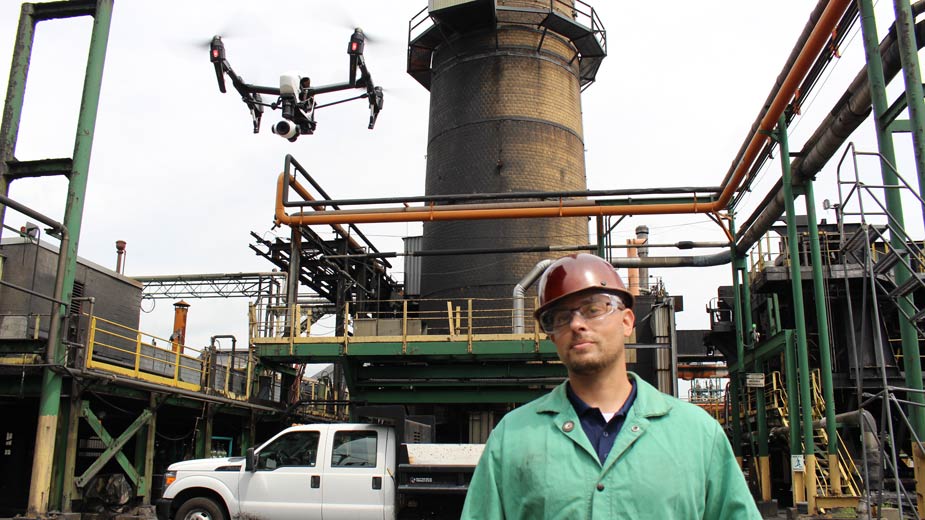Commercial Drones Take to the Skies
WARREN, Ohio — Aaron Campbell waits a few moments until the last drop of rain passes. He’s prepared to take off on this cloud-covered July morning, but rain could risk damaging the small aircraft he’s about to pilot.
For now though, all is clear as a window of good weather opens up. Campbell trains his eyes on a monitor the size of an iPad as he adjusts hand-held controls and readies for flight. Within minutes, the aircraft lifts vertically from a small helipad near the tall brick battery stack at the ArcelorMittal coke plant here.
Campbell isn’t your typical commercial pilot – he’s licensed to fly drones. In this case, the drone he’s maneuvering is a four-propeller device the size of an average model aircraft. The drone is equipped with an ultra-high resolution camera that the company he works for, Globex Corp., uses to inspect industrial sites from the air.
“There’s a big difference between flying a drone in a park and flying in a steel plant, or undergoing a search and rescue mission,” Campbell says.
The drone rises to about 225 feet to take photographs of ArcelorMittal’s battery stack as the chief engineer of the plant, Joe Magni, watches the screen in real time. The small craft can transmit visuals as it swings around the entire stack, and can zoom in to provide video and pictures in more intricate detail.
Normally, such inspections require an individual atop a crane or an inspector to scale a ladder alongside the 225-foot structure. A drone, flown in the right hands, can perform these inspections robotically, saving the company money while reducing the risk of injury to a worker.
“It could cost a company about $8,000 a day” to rent a large crane or a boom lift, says Brad Garwacki, Globex chief operating officer. Globex is an engineering and design firm based in Canfield, and a segment of its business provides inspection services for industrial clients.
Several months ago, the company seized upon an innovative method to save its clients money – using drone technology to provide inspection services in place of someone out in the field. “We’re able to put the drone up in the air, look for deficiencies in structures and come back with photo footage and provide a report to our clients,” Garwacki says.
The company owns two drones, one being the high-end model used for industrial inspections. The second is a backup that Globex can use as necessary. These drones are outfitted with high-resolution cameras whose lenses have the capability to zoom in close to the targeted area.
 Jeff Overly, business manager, Brad Garwacki, chief operating officer, and Aaron Campbell display one of the drones.
Jeff Overly, business manager, Brad Garwacki, chief operating officer, and Aaron Campbell display one of the drones.
“We do a lot with small cracks, missing bolts – very intricate things that you have to see in clear detail,” Garwacki says.
The visuals transmitted by the drone at the ArcelorMittal plant are remarkably clear and steady, despite wind gusts that appear to toss the lightweight craft back and forth as it hovers around the stack. The craft locks its transmission in place through a satellite connection, which enables a clear, detailed picture.
The camera alone costs upward of $9,000, and can transmit thermal images to detect hot areas of a particular structure, Garwacki adds.
It’s a technology that is becoming more common across the industry. While it’s not unusual for some clients to express skepticism at first, once they’ve seen the quality of the inspection work, they are much more open to use drone services.
“We’ve found it very effective and look forward to growing this division with Globex and see what we can provide with it,” Garwacki says.
Still, drones have their limitations. First, battery technology allows a flight time of roughly 20 minutes, so Globex has a pack of several batteries charged to power a single drone for repeated flights. As this technology improves, so will the market for the service and sales.
According to Connecticut-based technology research firm Gartner Inc., total global drone unit sales rose to 2.2 million in 2016 while revenues soared 36% to $4.5 billion. That number is projected to surpass $6 billion this year, the firm estimates.
Gartner also found that commercial and personal drone markets are starting to overlap as lower-priced hobby crafts are increasingly used for commercial purposes. “Personal drone vendors are now aggressively trying to position themselves in the commercial market,” Gerald Van Hoy, senior research analyst at Gartner, said in a statement.
Nevertheless, commercial use of drones is on the rise across the country and in northeastern Ohio.
Jeff Overly, business manager at Globex, says drone inspections enable the company’s clients to save money while providing a safe alternative. “It’s a safe, economical, easy access to roof inspections, stack inspections – natural gas companies have flare inspections,” he says.
Globex is working with its customer base in the steel industry to inspect roofs, gutters and property lines, Overly says. He also sees ample opportunity in the oil and gas industry, which would use the service for aerial pipeline inspections. “Also, the solar panel companies and cell phone towers are using this technology,” he says.
Still, flying a drone isn’t as simple as running to your nearby hobby store and flying it around your backyard, says Globex’s Campbell, its drone pilot.
Campbell is a certified commercial drone pilot, a credential that he needed before he could operate a drone for Globex. “There’s a big difference between flying for a hobby and flying commercially,” he emphasizes.
As a commercial drone pilot, Campbell had to pass what is called a Part 107 exam. This test encompasses a broad range of questions that involve all of the intricacies of commercial drone operations – including Federal Aviation Administration regulations, commercial flying mandates, software updates, satellite positioning, troubleshooting, checking airspace, mapping, a pre-flight checklist and how to properly maneuver the craft.
“It has very little to do with how drones fly,” Campbell says of the training. “It has a lot to do with how to operate in the national air space safely,” he says. “It’s a pretty difficult test.”
In the future, it’s likely companies or organizations will be able to purchase their own drones and perform inspections themselves, Campbell says. And this would create a demand for licensed pilots whom these companies would hire to fly drones. Safety patrols, for example, could use drones for search-and-rescue operations, while this technology could also be used for firefighting services.
This demand has inspired Globex to host a “drone school” at its offices in Canfield. The objective is to train drone pilots and prepare them for the Part 107 exam, says Campbell, who teaches the two-day course.
“The class we teach is 60% out in the field flying drones in a commercial manner,“ Campbell says. “The other 40% is classroom time, going over a lot of the material that students can expect to see on their Part 107 exam.” The first class is scheduled for the end of July.
Campbell says the drone industry is heavily regulated, adding that the FAA isn’t quite sure how to incorporate drones in the national airspace system. “You’re not allowed to fly [one] outside the line of sight,” he says, which as matters stand, prohibits drone deliveries. “There is progress being made for safe ways to fly outside the line of sight,” he says.
In some instances, waivers are granted to allow pilots to fly drones outside the line of sight and at night, but such waivers are hard to obtain, he says.
Once federal regulations become clearer, the market for commercial drones should rapidly expand. “Package delivery, real estate, agriculture, insurance – the list goes on,” Campbell says.
Drones equipped with thermal-imaging cameras are useful in the agriculture industry, Campbell says. “You can tell if you have pest problems or fungus problems on your crops because there’s increased metabolic activity in plants, which generates heat,” he says. Such technology could detect “hot spots” on electrical wires, a symptom of corrosion along a power line, he says.
Firefighters can send a drone over a house to guard against “re-flashes,” and the potential of a fire re-igniting, Campbell says. “There are also all the different search and rescue operations that drones are used for.”
Drones are also excellent tools for precision mapping and measuring, Campbell says, and through modeling software can create 3-D computer images of industrial and commercial sites, Campbell says.
“The applications for this technology are endless.”
Pictured at top: Aaron Campbell, chief drone pilot for Globex Corp., launches a drone at ArcelorMittal’s coke plant in Warren.
Copyright 2024 The Business Journal, Youngstown, Ohio.



